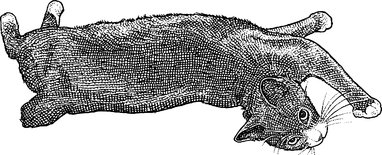The Wall Street Journal
In the World of Cat Fiction, Fur Flies Over Whether Stars Get Speaking Roles
Claws come out as chatty kitties rack up awards; one author decides to turn tail
Shirley Rousseau Murphy swings a big tail in the world of cat fiction. Her “Joe Grey Mystery” series has more than a million copies in print and the Cat Writers’ Association has awarded her a medallion for best novel 11 times. In her books, a pair of talking cats help police solve crimes.
Patricia Fry is the author of the “Klepto Cat Mystery” series. Describing the first installation on her website, the author reassured readers: “Don’t worry, there are no talking cats.”

Cat mysteries are a subgenre of cozy mysteries—detective stories typically set in small towns and intended as clean, gentle fun, with minimal sex, violence and profanity. There’s nothing genteel, however, about the debate among authors and fans over whether cats’ tongues should be tied.
Ms. Murphy’s talking Joe Grey leaves evidence in squad cars. He also has the police chief on speed dial. In Ms. Fry’s series, a thieving tomcat named Rags silently collects business cards, photographs and a pouch of diamonds—clues to murders, kidnappings and a jewelry heist.
When it comes to cats and speech, “people tend to feel very strongly about it,” says Clea Simon, whose first cat mystery, “Mew is for Murder,” featured silent kitties. Once, during a mystery conference panel, “I got up there and said, ‘Cats that speak, they’re an abomination.’ ”
Then she turned tail and wrote a book about a talking ghost cat.
“I realized at some point that we all talk to our pets,” says Ms. Simon, 54, of Somerville, Mass. “And most of us imagine the other side of the dialogue.”
Founded in 1992, the Cat Writers’ Association has often leaned in favor of verbose types, awarding its top fiction prize to books featuring chatty-cat characters.
Last week, Ms. Murphy, who is 87 and lives in Carmel, Calif., published the 19th installment of her mystery series, titled “Cat Shout for Joy.” It missed the deadline for this year’s competition, leaving an opening for a silent cat to slink in. Author Carole Nelson Douglas (a three-time winner) has a hero named Midnight Louie—a Sam Spade in black fur—who narrates her books but doesn’t deign to speak to bipeds. Ms. Fry also hopes to catch a prize with her “Klepto Cat” series.
Talking cats have a long literary history, much of it in children’s stories, from “Puss in Boots” and the Cheshire Cat to the “The Cat in the Hat.” But they have appeared in works for adults, too, including Saki’s “Tobermory” and T.S. Eliot’s “Old Possum’s Book of Practical Cats” (upon which the musical “Cats” is based).
“So many fans tell me they wish their cats could speak,” says Ms. Murphy, whose series, which began in 1996, has 1.3 million copies in print, according to her publisher, HarperCollins, which, like The Wall Street Journal, is owned by News Corp.
“Sometimes I say, ‘Are you sure you want to know? They might be thinking something not flattering.’ ”
The original grande dame of cat mysteries was Lilian Jackson Braun, author of the best-selling “Cat Who” series. She died in 2011 at 97. Her series began in 1966 with “The Cat Who Could Read Backwards” and concluded in 2007 with the 29th volume, “The Cat Who Had 60 Whiskers.”
Author Amy Shojai, a founder of the Cat Writers’ Association, falls into the mute-cat camp.
“It was important to me to represent cats in a realistic way,” says Ms. Shojai, who is also an animal-behavior consultant. “They are beyond human understanding in many ways.”
On the book-recommendations site Goodreads, the verbal vs. nonverbal debate gets heated. Fans urge skeptics to give feline fantasy a chance. Others draw a firm line.
“I don’t want talking cats,” a Goodreads reviewer identified as Lesa from Evansville, Ind., wrote about a book called “The Whole Cat and Caboodle.” “I like my cats to be cats, even if they do help to solve cases.”
Leslie Ramalho, a fan of the “Joe Grey” series who has corresponded with Ms. Murphy, feels differently.
“The fact that the cats can speak, that adds to the fun,” says Ms. Ramalho, 62, a retired legal assistant who lives with her husband and four cats in Homosassa, Fla. “You kind of wonder, What are they thinking? If they’re sitting there looking out the window, what would they say?”
Writer Rita Mae Brown is the “co-author,” along with her cat, Sneaky Pie Brown, of a mystery series called “Mrs. Murphy.” The 25 titles, including the latest due out in May, have more than 5.1 million copies in print, according to her publisher, Penguin Random House’s Bantam imprint.
The author lives on a Virginia farm with horses, fox hounds and barns full of feral cats. Ms. Brown is known for her 1973 novel “Rubyfruit Jungle,” a groundbreaking portrayal of lesbianism. Her more recent cat mysteries feature fictional felines who chat among themselves—and to other animals—but not to people.
“Animals do have language,” says Ms. Brown, 71. “Think about it. If you are a cat… you can puff up enormously, you can change the pupils of your eyes, move your whiskers back and forth. All of that means something.”
Ms. Brown hadn’t heard of the Cat Writers’ Association until a Wall Street Journal reporter told her about it a few weeks ago. Ms. Brown’s newest installment, “Tall Tail,” comes out in May. Her publisher plans to enter it in the association’s next competition.
Write to Jennifer Maloney at jennifer.maloney@wsj.com
This piece ran on Feb. 29, 2016 in the Wall Street Journal: https://www.wsj.com/articles/in-the-world-of-cat-fiction-fur-flies-over-whether-stars-get-speaking-roles-1456799256
